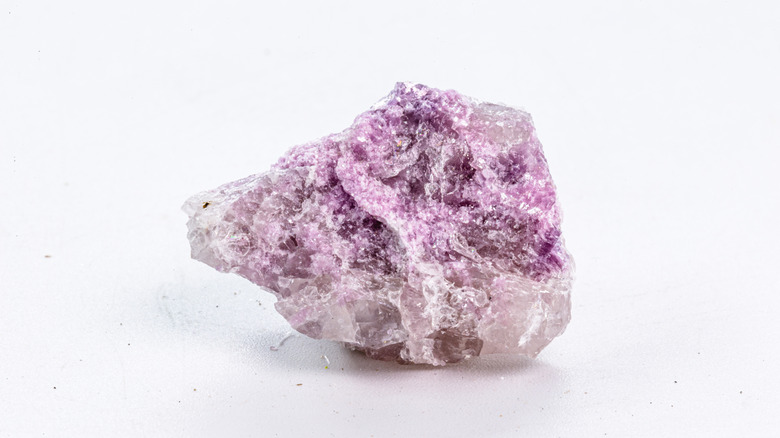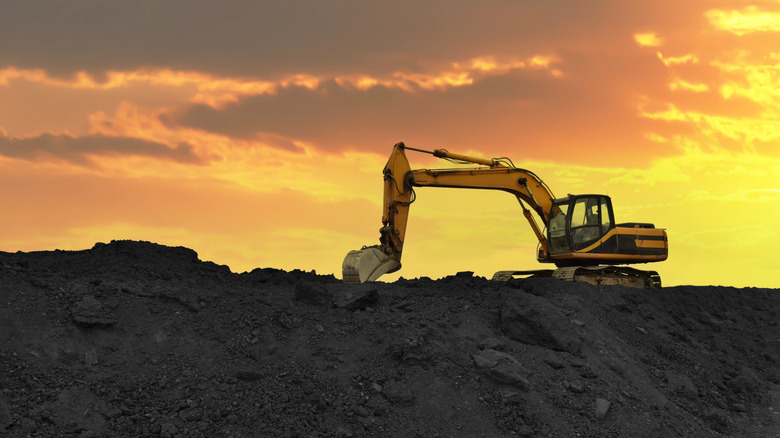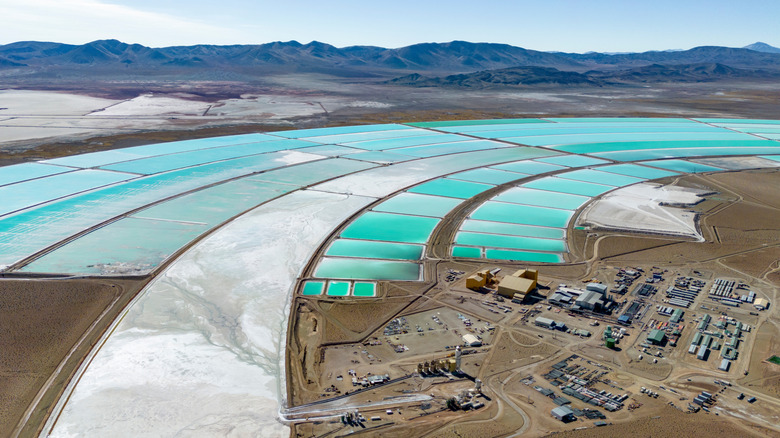Here's Why Lithium Is Such A Valuable And Expensive Metal
The discovery of a vast metal deposit in the U.S. recently made headlines, with geological surveys estimating the find to have an extractable mass of 20 to 40 million metric tons. Even more mind-boggling is the estimated value of the deposit, with some placing its price at $1.5 trillion. But the prospectors didn't strike gold — they struck lithium.
While the $1.5 trillion number is doubtful, lithium is indeed a highly valued resource. The metal has become coveted in recent decades due to the rise of the lithium-ion battery. Lighter in weight and higher in capacity than traditional acid batteries, lithium batteries can be found in everything from smartphones, laptops, electric vehicles, and renewable energy storage for city electrical grids. Lithium is used in other applications as well, such as building materials like ceramics and glass. However, according to the World Nuclear Organization, about 75% of all lithium mined globally is used in batteries. Even more telling, that proportion is rising fast. In 2016, that number was 40%, and experts predict it will rise to 90% in the future.
While the demand for lithium has risen, the supply isn't projected to drop. Global reserves of extractable lithium are considered "relatively abundant" by U.S. geological surveys. If the global lithium supply were to ever run dry, it would most likely be caused by other scenarios, such as supply chain disruptions, environmental mandates, or severed international trade agreements. Thus, because the price of lithium depends less on supply and more on demand, two main factors drive up its value: the massive mining companies that determine its sales price and the production costs involved. Add to that the difficulties surrounding lithium recycling, and you'll begin to see how a vein of lithium ore in the Northwest U.S. can earn a huge price tag.
How a few countries determine the price of lithium
Lithium may be considered "relatively abundant," but that doesn't mean you can find it just anywhere. Only a handful of countries are responsible for producing the majority of the world's supply. Operating within those countries, only a handful of large companies have the mining rights to produce lithium on a large scale. As you might expect, those companies have a powerful influence over the price.
The top five lithium-producing countries are responsible for over half of the global supply. The rankings shift every year as countries vie to meet demand, but the top spots are typically occupied by Australia, Chile, China, Zimbabwe, and Argentina. Brazil, Canada, the United States, and Portugal also produce significant amounts of the global lithium supply. Beyond those top producers, the rest of the countries in the world produce a marginal amount of lithium. Yet, while major lithium sources are restricted to fewer than a dozen countries, the demand for lithium is global. As a result, the balance between supply and demand is heavily influenced by inflation and currency fluctuations, as the lithium supply chain often spans multiple international borders. That's where pricing strategies come into play.
The biggest lithium companies coordinate pricing strategies to maintain control over prices in the face of market fluctuations. In a nutshell, big companies with big government contracts determine the maximum price they can charge for their product without losing customers while also factoring in the cost of production. It's not quite the same market manipulation as the diamond industry, for example, where supply is withheld to create artificial scarcity and pump up the value. Still, the lithium market is cornered and controlled by just a handful of a few huge companies.
The production costs of lithium extraction
While the sale price of lithium is controlled by the market, the production cost is determined by the expenses involved in extracting it. There are two main ways that lithium is mined: salt-flat brines and hard rock mining. About 80% of all lithium is extracted via salt-flat brines. It's the preferred method in flat desert regions, like those found in Argentina, Bolivia, and Brazil, where underground aquifers contain dissolved lithium salts. The saltwater is pumped out of the ground and into pools and then left to evaporate in the sun. Once much of the water has evaporated, the concentrated brine solution left over is further processed to extract the lithium. The next most common method of lithium extraction is hard rock mining. The types of lithium mines vary, from open-pit to underground tunnels, though the method is fundamentally the same. Rocks are fractured from the earth, broken into chunks, and transported for further processing.
Salt-flat brines are much cheaper than hard rock mines. Hard rock mining requires fancy equipment and many human operators to extract and move the rock, while salt-flat brines require fewer operators and equipment. Processing is also cheaper, since a big portion of refining brine is performed by sunlight. Estimates vary, but some sources place brine-based production costs at around $4,000 to $6,000 per metric ton and hard rock mining at around $8,000 per metric ton. Considering the sales price of lithium, which fluctuates wildly but has recently hovered around $9,000 per metric ton, production costs make up a significant portion of lithium prices.
Sadly, the cost of lithium production isn't so straightforward. The environmental impact from mining has ecological costs that are often disregarded and left unpaid. As expected, such negative externalities aren't factored into lithium's price.


